2004 LINCOLN TOWN CAR jump start
[x] Cancel search: jump startPage 2 of 304
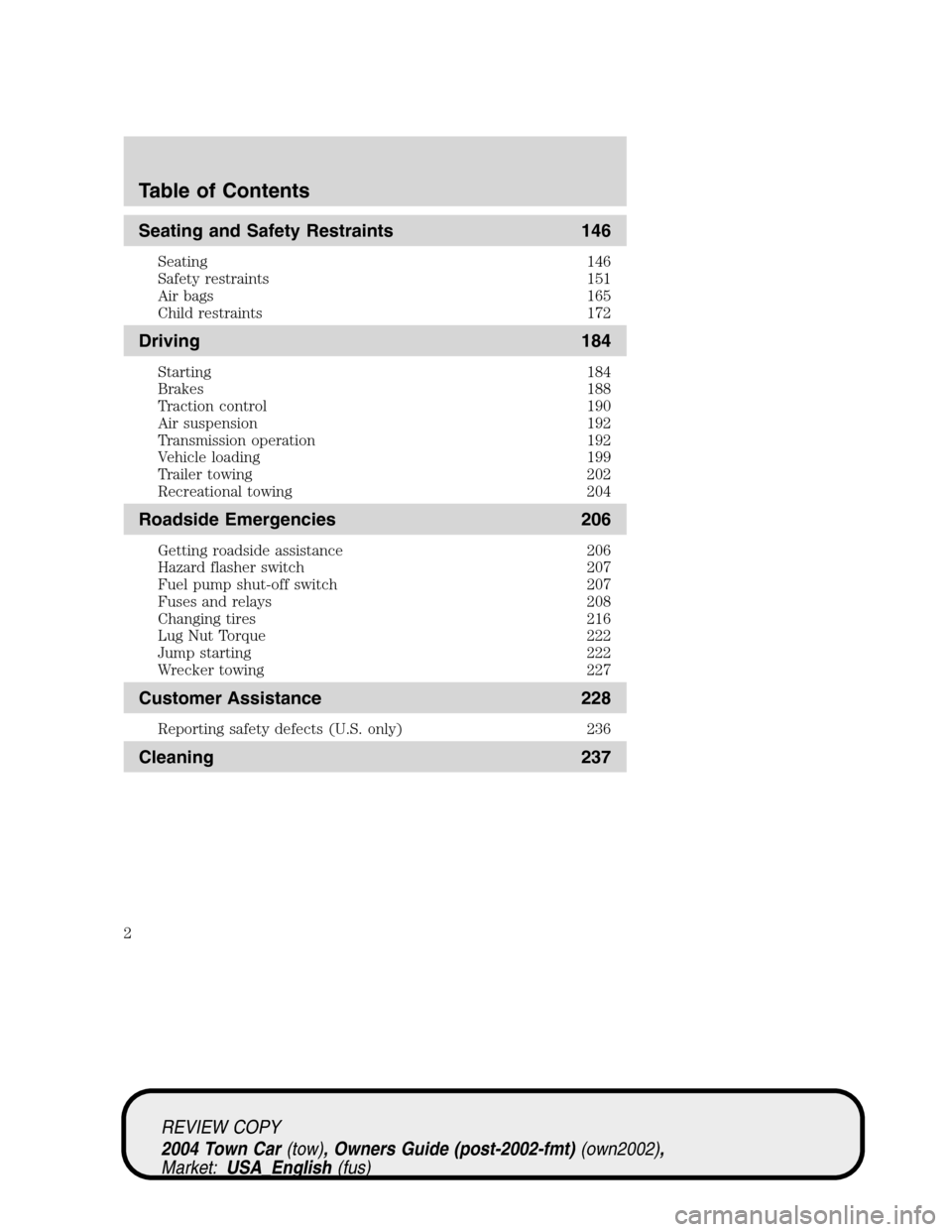
Seating and Safety Restraints 146
Seating 146
Safety restraints 151
Air bags 165
Child restraints 172
Driving 184
Starting 184
Brakes 188
Traction control 190
Air suspension 192
Transmission operation 192
Vehicle loading 199
Trailer towing 202
Recreational towing 204
Roadside Emergencies 206
Getting roadside assistance 206
Hazard flasher switch 207
Fuel pump shut-off switch 207
Fuses and relays 208
Changing tires 216
Lug Nut Torque 222
Jump starting 222
Wrecker towing 227
Customer Assistance 228
Reporting safety defects (U.S. only) 236
Cleaning 237
Table of Contents
2
REVIEW COPY
2004 Town Car(tow), Owners Guide (post-2002-fmt)(own2002),
Market:USA_English(fus)
Page 206 of 304
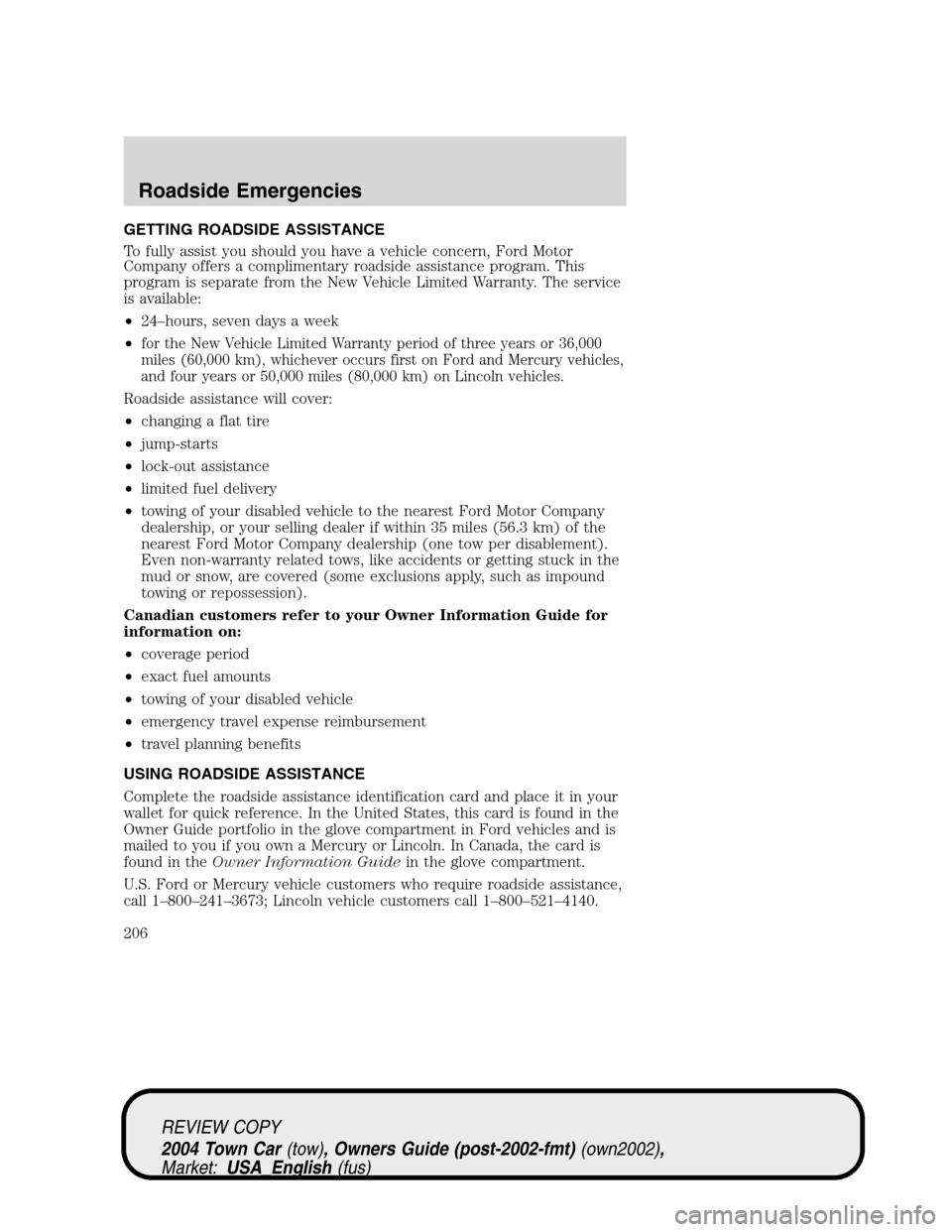
GETTING ROADSIDE ASSISTANCE
To fully assist you should you have a vehicle concern, Ford Motor
Company offers a complimentary roadside assistance program. This
program is separate from the New Vehicle Limited Warranty. The service
is available:
•24–hours, seven days a week
•
for the New Vehicle Limited Warranty period of three years or 36,000
miles (60,000 km), whichever occurs first on Ford and Mercury vehicles,
and four years or 50,000 miles (80,000 km) on Lincoln vehicles.
Roadside assistance will cover:
•changing a flat tire
•jump-starts
•lock-out assistance
•limited fuel delivery
•towing of your disabled vehicle to the nearest Ford Motor Company
dealership, or your selling dealer if within 35 miles (56.3 km) of the
nearest Ford Motor Company dealership (one tow per disablement).
Even non-warranty related tows, like accidents or getting stuck in the
mud or snow, are covered (some exclusions apply, such as impound
towing or repossession).
Canadian customers refer to your Owner Information Guide for
information on:
•coverage period
•exact fuel amounts
•towing of your disabled vehicle
•emergency travel expense reimbursement
•travel planning benefits
USING ROADSIDE ASSISTANCE
Complete the roadside assistance identification card and place it in your
wallet for quick reference. In the United States, this card is found in the
Owner Guide portfolio in the glove compartment in Ford vehicles and is
mailed to you if you own a Mercury or Lincoln. In Canada, the card is
found in theOwner Information Guidein the glove compartment.
U.S. Ford or Mercury vehicle customers who require roadside assistance,
call 1–800–241–3673; Lincoln vehicle customers call 1–800–521–4140.
REVIEW COPY
2004 Town Car(tow), Owners Guide (post-2002-fmt)(own2002),
Market:USA_English(fus)
Roadside Emergencies
Roadside Emergencies
206
Page 222 of 304
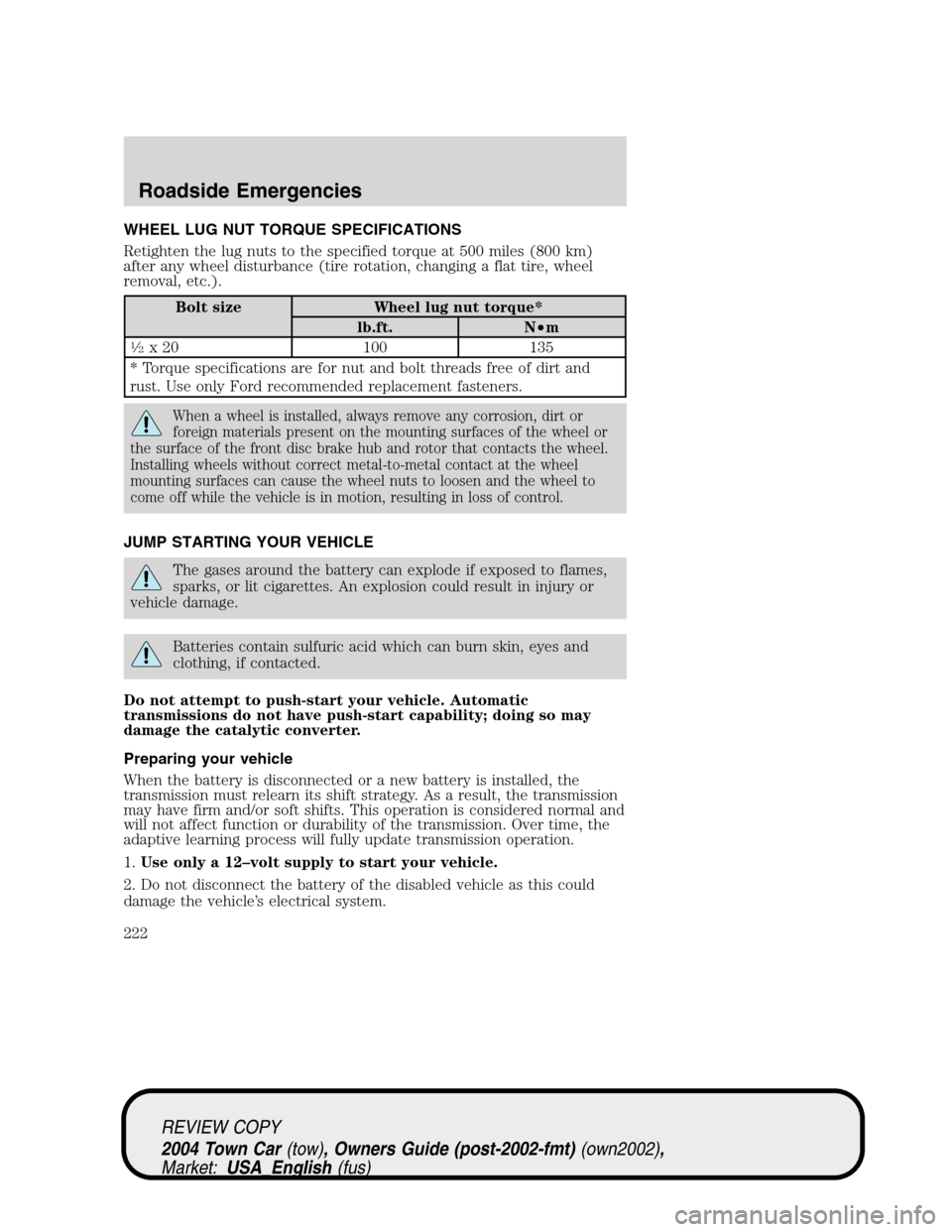
WHEEL LUG NUT TORQUE SPECIFICATIONS
Retighten the lug nuts to the specified torque at 500 miles (800 km)
after any wheel disturbance (tire rotation, changing a flat tire, wheel
removal, etc.).
Bolt size Wheel lug nut torque*
lb.ft. N•m
1⁄2x 20 100 135
* Torque specifications are for nut and bolt threads free of dirt and
rust. Use only Ford recommended replacement fasteners.
When a wheel is installed, always remove any corrosion, dirt or
foreign materials present on the mounting surfaces of the wheel or
the surface of the front disc brake hub and rotor that contacts the wheel.
Installing wheels without correct metal-to-metal contact at the wheel
mounting surfaces can cause the wheel nuts to loosen and the wheel to
come off while the vehicle is in motion, resulting in loss of control.
JUMP STARTING YOUR VEHICLE
The gases around the battery can explode if exposed to flames,
sparks, or lit cigarettes. An explosion could result in injury or
vehicle damage.
Batteries contain sulfuric acid which can burn skin, eyes and
clothing, if contacted.
Do not attempt to push-start your vehicle. Automatic
transmissions do not have push-start capability; doing so may
damage the catalytic converter.
Preparing your vehicle
When the battery is disconnected or a new battery is installed, the
transmission must relearn its shift strategy. As a result, the transmission
may have firm and/or soft shifts. This operation is considered normal and
will not affect function or durability of the transmission. Over time, the
adaptive learning process will fully update transmission operation.
1.Use only a 12–volt supply to start your vehicle.
2. Do not disconnect the battery of the disabled vehicle as this could
damage the vehicle’s electrical system.
REVIEW COPY
2004 Town Car(tow), Owners Guide (post-2002-fmt)(own2002),
Market:USA_English(fus)
Roadside Emergencies
222
Page 224 of 304
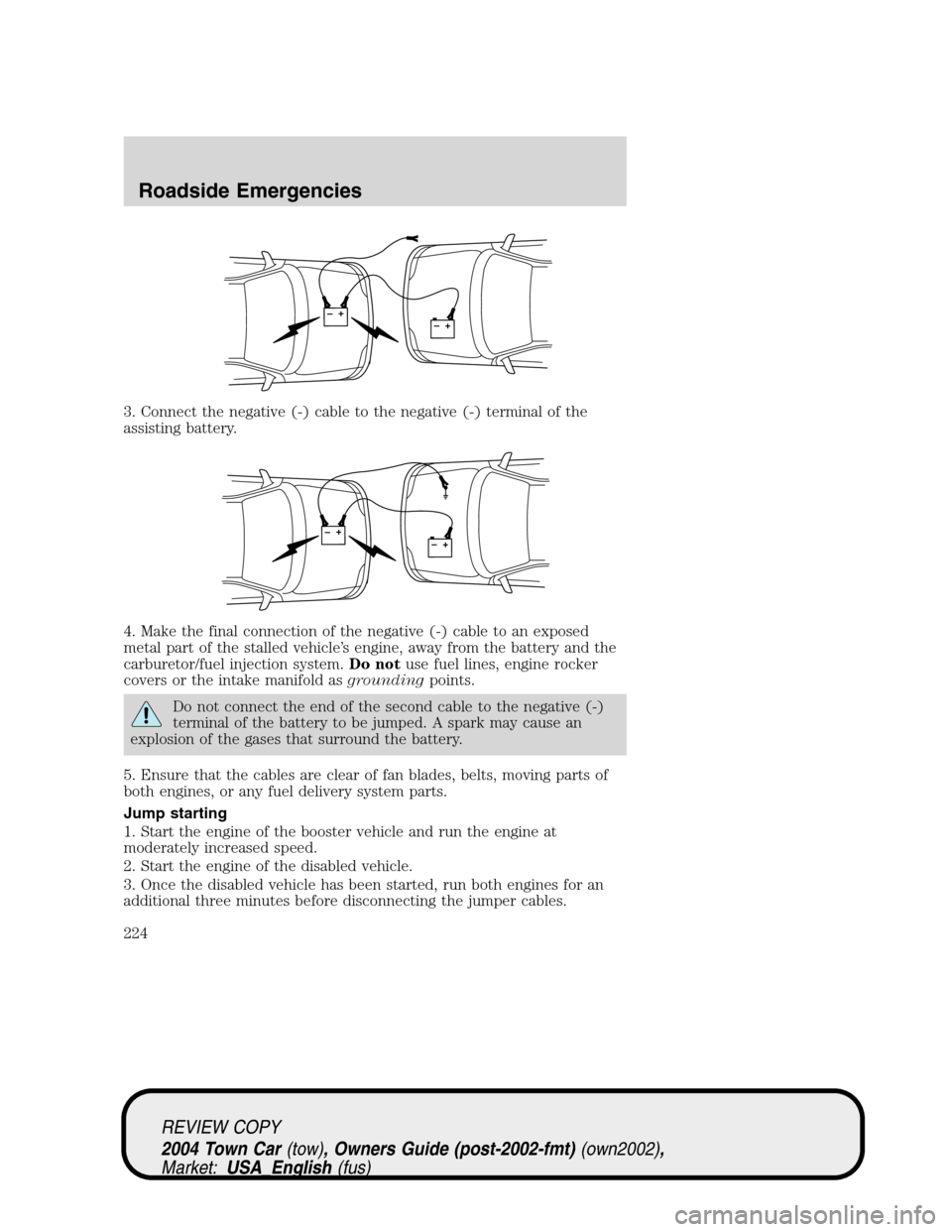
3. Connect the negative (-) cable to the negative (-) terminal of the
assisting battery.
4. Make the final connection of the negative (-) cable to an exposed
metal part of the stalled vehicle’s engine, away from the battery and the
carburetor/fuel injection system.Do notuse fuel lines, engine rocker
covers or the intake manifold asgroundingpoints.
Do not connect the end of the second cable to the negative (-)
terminal of the battery to be jumped. A spark may cause an
explosion of the gases that surround the battery.
5. Ensure that the cables are clear of fan blades, belts, moving parts of
both engines, or any fuel delivery system parts.
Jump starting
1. Start the engine of the booster vehicle and run the engine at
moderately increased speed.
2. Start the engine of the disabled vehicle.
3. Once the disabled vehicle has been started, run both engines for an
additional three minutes before disconnecting the jumper cables.
+–+–
+–+–
REVIEW COPY
2004 Town Car(tow), Owners Guide (post-2002-fmt)(own2002),
Market:USA_English(fus)
Roadside Emergencies
224
Page 226 of 304

3. Remove the jumper cable from the positive (+) terminal of the booster
vehicle’s battery.
4. Remove the jumper cable from the positive (+) terminal of the
disabled vehicle’s battery.
After the disabled vehicle has been started and the jumper cables
removed, allow it to idle for several minutes so the engine computer can
relearnits idle conditions.
+–+–
+–+–
REVIEW COPY
2004 Town Car(tow), Owners Guide (post-2002-fmt)(own2002),
Market:USA_English(fus)
Roadside Emergencies
226
Page 299 of 304
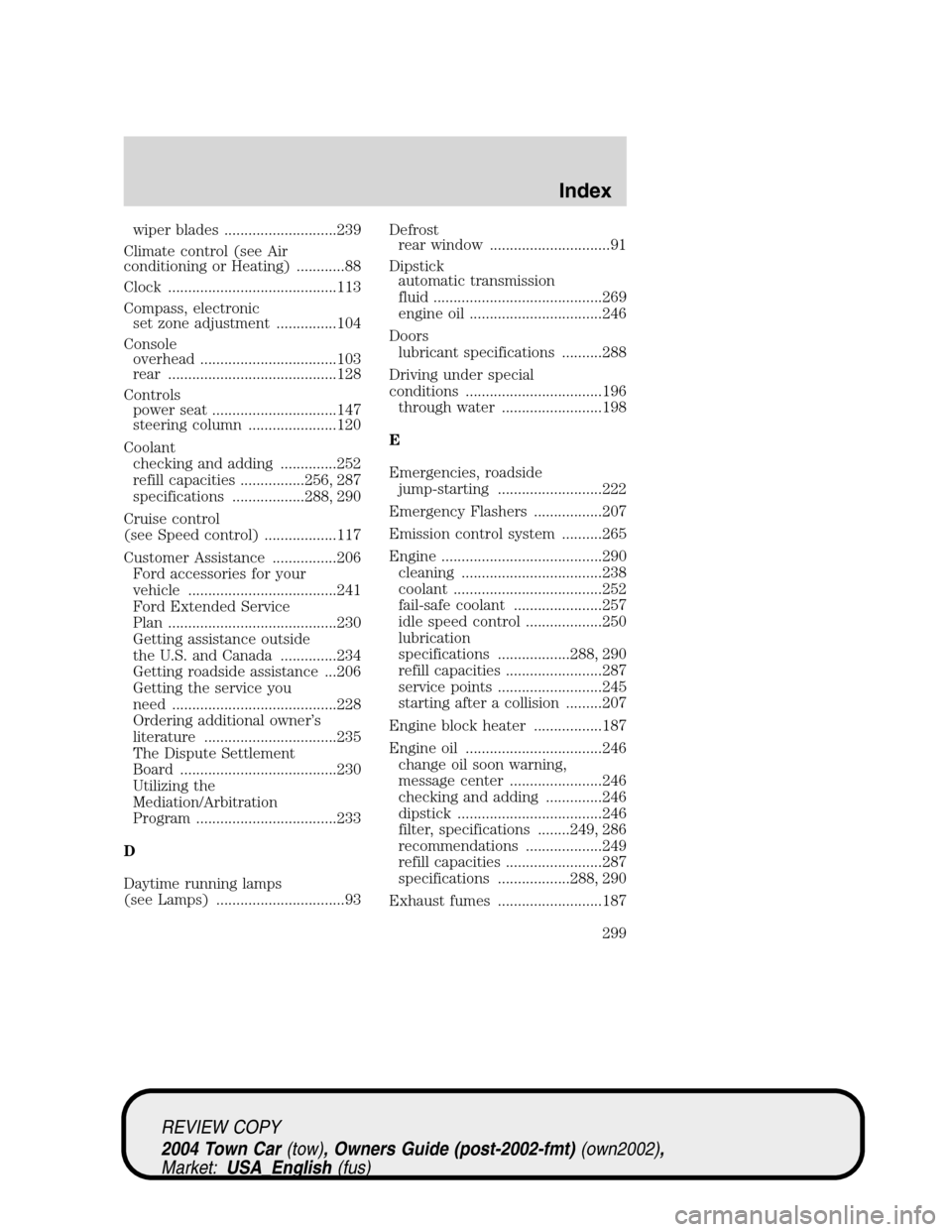
wiper blades ............................239
Climate control (see Air
conditioning or Heating) ............88
Clock ..........................................113
Compass, electronic
set zone adjustment ...............104
Console
overhead ..................................103
rear ..........................................128
Controls
power seat ...............................147
steering column ......................120
Coolant
checking and adding ..............252
refill capacities ................256, 287
specifications ..................288, 290
Cruise control
(see Speed control) ..................117
Customer Assistance ................206
Ford accessories for your
vehicle .....................................241
Ford Extended Service
Plan ..........................................230
Getting assistance outside
the U.S. and Canada ..............234
Getting roadside assistance ...206
Getting the service you
need .........................................228
Ordering additional owner’s
literature .................................235
The Dispute Settlement
Board .......................................230
Utilizing the
Mediation/Arbitration
Program ...................................233
D
Daytime running lamps
(see Lamps) ................................93Defrost
rear window ..............................91
Dipstick
automatic transmission
fluid ..........................................269
engine oil .................................246
Doors
lubricant specifications ..........288
Driving under special
conditions ..................................196
through water .........................198
E
Emergencies, roadside
jump-starting ..........................222
Emergency Flashers .................207
Emission control system ..........265
Engine ........................................290
cleaning ...................................238
coolant .....................................252
fail-safe coolant ......................257
idle speed control ...................250
lubrication
specifications ..................288, 290
refill capacities ........................287
service points ..........................245
starting after a collision .........207
Engine block heater .................187
Engine oil ..................................246
change oil soon warning,
message center .......................246
checking and adding ..............246
dipstick ....................................246
filter, specifications ........249, 286
recommendations ...................249
refill capacities ........................287
specifications ..................288, 290
Exhaust fumes ..........................187
REVIEW COPY
2004 Town Car(tow), Owners Guide (post-2002-fmt)(own2002),
Market:USA_English(fus)
Index
299
Page 300 of 304
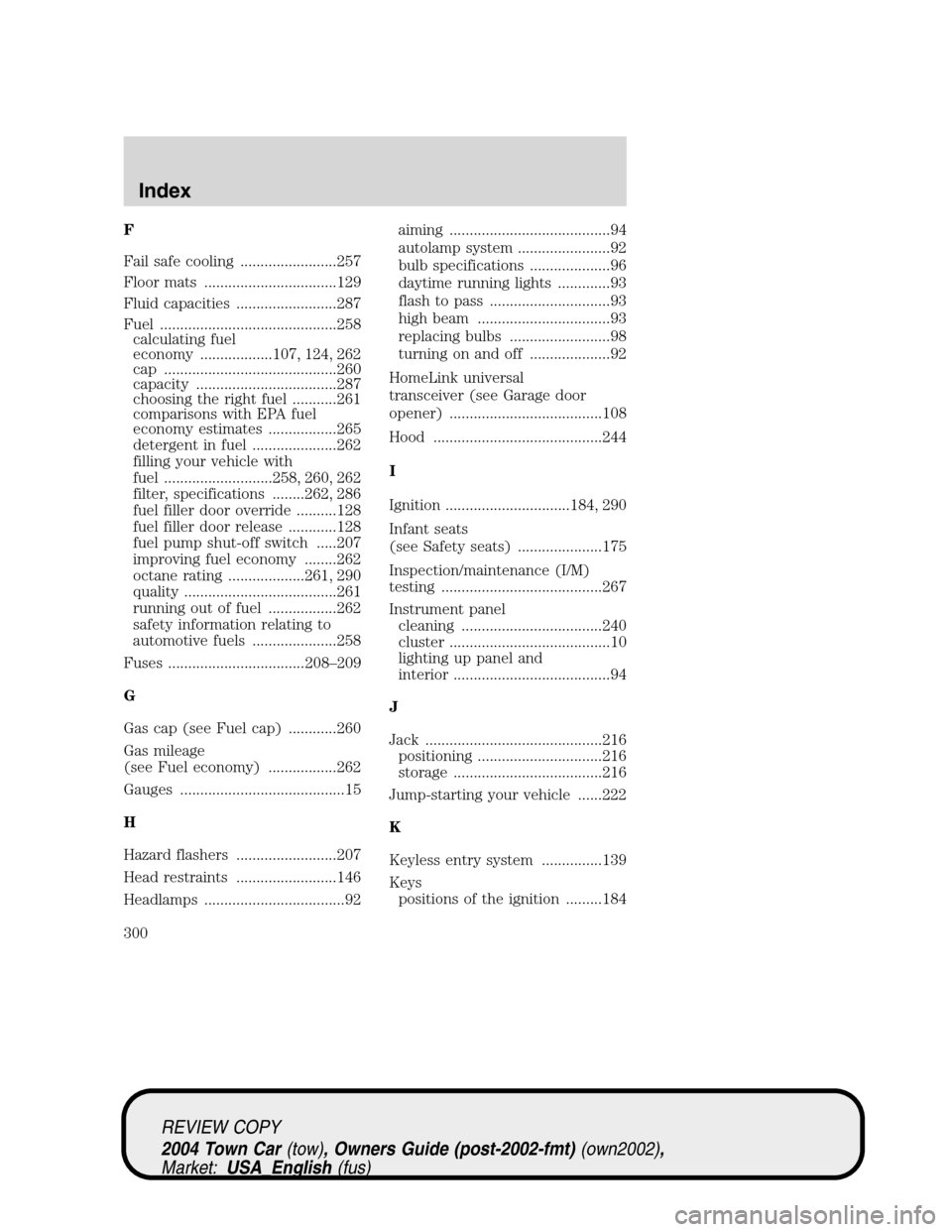
F
Fail safe cooling ........................257
Floor mats .................................129
Fluid capacities .........................287
Fuel ............................................258
calculating fuel
economy ..................107, 124, 262
cap ...........................................260
capacity ...................................287
choosing the right fuel ...........261
comparisons with EPA fuel
economy estimates .................265
detergent in fuel .....................262
filling your vehicle with
fuel ...........................258, 260, 262
filter, specifications ........262, 286
fuel filler door override ..........128
fuel filler door release ............128
fuel pump shut-off switch .....207
improving fuel economy ........262
octane rating ...................261, 290
quality ......................................261
running out of fuel .................262
safety information relating to
automotive fuels .....................258
Fuses ..................................208–209
G
Gas cap (see Fuel cap) ............260
Gas mileage
(see Fuel economy) .................262
Gauges .........................................15
H
Hazard flashers .........................207
Head restraints .........................146
Headlamps ...................................92aiming ........................................94
autolamp system .......................92
bulb specifications ....................96
daytime running lights .............93
flash to pass ..............................93
high beam .................................93
replacing bulbs .........................98
turning on and off ....................92
HomeLink universal
transceiver (see Garage door
opener) ......................................108
Hood ..........................................244
I
Ignition ...............................184, 290
Infant seats
(see Safety seats) .....................175
Inspection/maintenance (I/M)
testing ........................................267
Instrument panel
cleaning ...................................240
cluster ........................................10
lighting up panel and
interior .......................................94
J
Jack ............................................216
positioning ...............................216
storage .....................................216
Jump-starting your vehicle ......222
K
Keyless entry system ...............139
Keys
positions of the ignition .........184
REVIEW COPY
2004 Town Car(tow), Owners Guide (post-2002-fmt)(own2002),
Market:USA_English(fus)
Index
300
Page 302 of 304
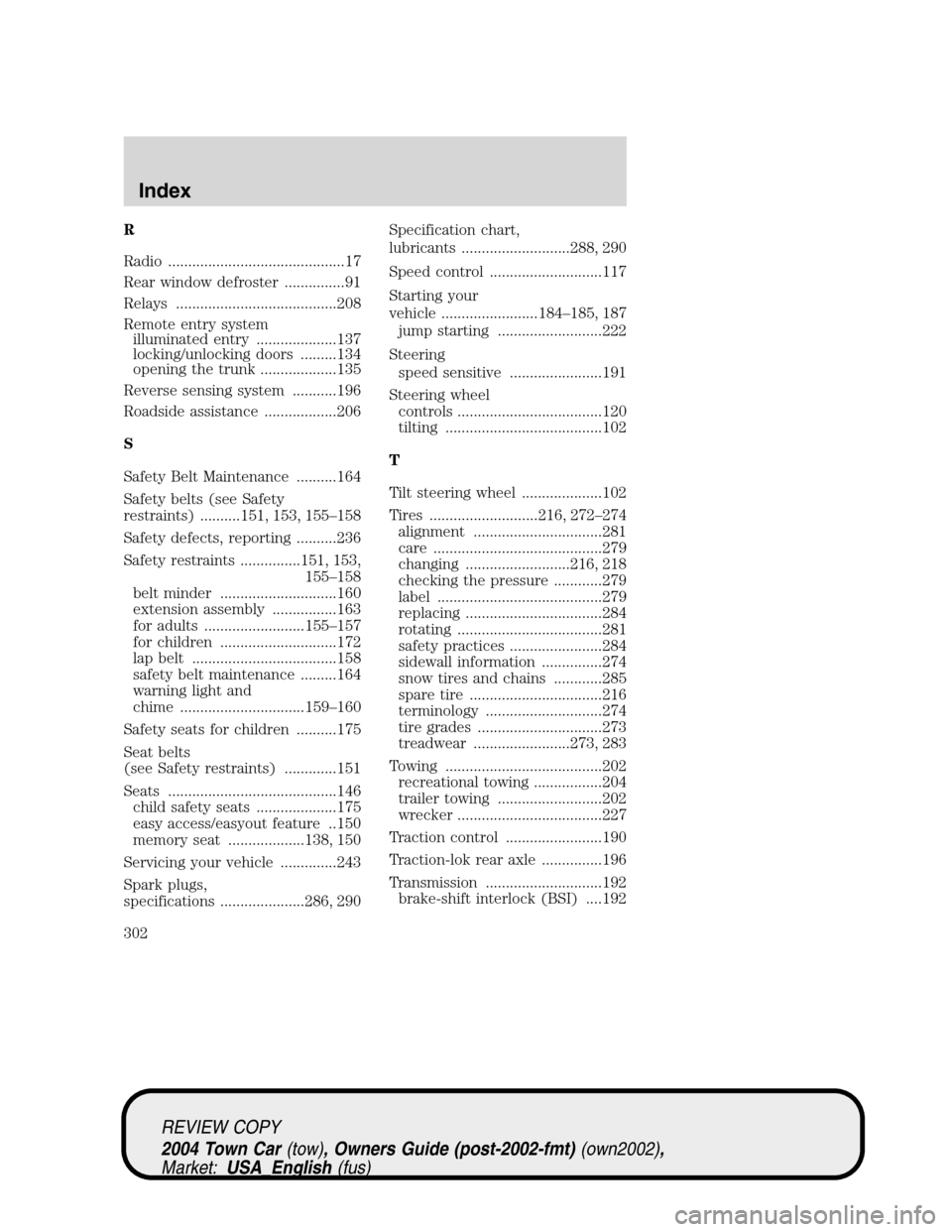
R
Radio ............................................17
Rear window defroster ...............91
Relays ........................................208
Remote entry system
illuminated entry ....................137
locking/unlocking doors .........134
opening the trunk ...................135
Reverse sensing system ...........196
Roadside assistance ..................206
S
Safety Belt Maintenance ..........164
Safety belts (see Safety
restraints) ..........151, 153, 155–158
Safety defects, reporting ..........236
Safety restraints ...............151, 153,
155–158
belt minder .............................160
extension assembly ................163
for adults .........................155–157
for children .............................172
lap belt ....................................158
safety belt maintenance .........164
warning light and
chime ...............................159–160
Safety seats for children ..........175
Seat belts
(see Safety restraints) .............151
Seats ..........................................146
child safety seats ....................175
easy access/easyout feature ..150
memory seat ...................138, 150
Servicing your vehicle ..............243
Spark plugs,
specifications .....................286, 290Specification chart,
lubricants ...........................288, 290
Speed control ............................117
Starting your
vehicle ........................184–185, 187
jump starting ..........................222
Steering
speed sensitive .......................191
Steering wheel
controls ....................................120
tilting .......................................102
T
Tilt steering wheel ....................102
Tires ...........................216, 272–274
alignment ................................281
care ..........................................279
changing ..........................216, 218
checking the pressure ............279
label .........................................279
replacing ..................................284
rotating ....................................281
safety practices .......................284
sidewall information ...............274
snow tires and chains ............285
spare tire .................................216
terminology .............................274
tire grades ...............................273
treadwear ........................273, 283
Towing .......................................202
recreational towing .................204
trailer towing ..........................202
wrecker ....................................227
Traction control ........................190
Traction-lok rear axle ...............196
Transmission .............................192
brake-shift interlock (BSI) ....192
REVIEW COPY
2004 Town Car(tow), Owners Guide (post-2002-fmt)(own2002),
Market:USA_English(fus)
Index
302